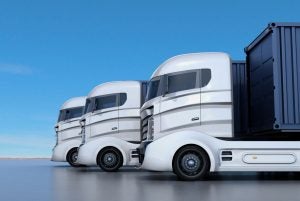Now is the time for California to go bold on electric trucks and buses
 There is no single fix to the climate, air quality, political and economic challenges facing California, but the state’s early action to electrify its fleet of medium- and heavy-duty vehicles is one example of smart policy that can move us in a positive direction. As California’s legislative session concludes in August, lawmakers and the California Air Resources Board should take the next steps to implement the electric transportation transition with tools that are right at their fingertips.
There is no single fix to the climate, air quality, political and economic challenges facing California, but the state’s early action to electrify its fleet of medium- and heavy-duty vehicles is one example of smart policy that can move us in a positive direction. As California’s legislative session concludes in August, lawmakers and the California Air Resources Board should take the next steps to implement the electric transportation transition with tools that are right at their fingertips.
Nationally, the transportation sector is the largest source of climate emissions and a primary contributor to local air pollution and the negative health and economic impacts that go along with it. Medium- and heavy- duty vehicles – the trucks and buses that move our goods and people – make up a small portion of total wheels on the road, but they produce an outsized portion of all emissions. In California, MHD vehicles make up just 6% of vehicles on the road, but produce 72% of the state’s health-harming nitrogen oxide emissions and 21% of all transportation climate emissions. Transitioning these vehicles to zero-emission models would make a big difference for air quality and the manufacturing economy, a sector where California is becoming a leader.
California is broadly moving toward electrification, and giving truck fleets and ZEV manufacturers in the state more tools will support the economy, clean air and communities. The Advanced Clean Trucks rule, passed by CARB in 2020, set goals for electric MHDV adoption and has become a model for other states and regions. Last year, Senator Leyva’s bill (SB 372) directed CARB and the state treasurer to develop a suite of financial incentives to help fleet owners begin the transition to ZEV models with high vote counts. In its final weeks, the legislature and CARB can build on these meaningful accomplishments.
Now is the time for California to go bold on electric trucks and buses Share on XOpportunities at the Capitol
Funding SB 372 with $60 million would provide more direct assistance for small trucking fleets and inspire more private financing for larger fleets while focusing largely on disadvantaged areas. New financing mechanisms would enable private finance to participate in California’s ZEV truck market, multiplying the economic investment of every public dollar and extending the state’s investments to more fleets.
The SB 372 ask is part of a larger $10 billion Invest in Clean Air transportation package request, that targets light-, medium- and heavy-duty vehicles. The light-duty programs are equity-focused programs and designed to increase access to zero-emission vehicles and mobility in disadvantaged and low-income communities, while the zero-emission medium- and heavy-duty vehicle programs are designed to displace toxic diesel emissions in communities near freeways, ports, railyards, warehouses and other facilities.
There are opportunities to support ZEV MHD trucks through non-controversial legislation too:
- SB 542 (Limon) and AB 2622 (Mullin) would give sales tax exemptions for ZEV trucks and transit buses.
- AB 1251 (Gonzalez) would create the Office of the Zero-Emission Vehicle Equity Advocate to help develop the state’s agenda for equity in ZEV vehicle deployment.
- SB 1010 (Skinner) would accelerate deployment of ZEV vehicles in the state fleet.
- AB 2836 would extend the Moyer funding program for lower-emission MHD vehicles, including ZEV.
- AB 2061 (Ting) would assess and takes steps towards shoring up ZEV charging infrastructure reliability, necessary if we want to move the whole state to ZEV.
Opportunities at CARB
Several state agencies have roles to play in the transportation transition, but CARB is particularly pivotal in getting ZEV trucks on the road.
The ACT requires manufacturers to offer ZEV models beginning in 2024 and ramping up through 2035, depending on the size of the truck. This regulation is projected to save the state at least $6 billion, mostly in lowered fuel costs and maintenance.
The Advanced Clean Fleets rule addresses the buyer side of the equation and requires fleet owners to begin buying the available models in 2024, with requirements depending on the type of fleet. A large coalition of advocates is pushing CARB to require 100% ZEV sales by 2035 to get the health, climate and economic benefits of ZEV more quickly.
CARB is also charged with implementing SB 372. The next few years will be critical if the bill is to have its intended effect and open up more funding for ZEV trucks. CARB is in the process of designing the program, but we expect it to grow over time, particularly in the development of programs that attract private finance.
A big opportunity for lasting impact
The legislature can take advantage of the few weeks it has left to make a huge difference. This important package of opportunities to spark the transition to cleaner trucks and buses will go a long way toward making the California we want to live in. These strategies, spanning our budget, to legislation, to CARB put us on solid ground to cleaner air, economic cost savings and a healthy economy.










